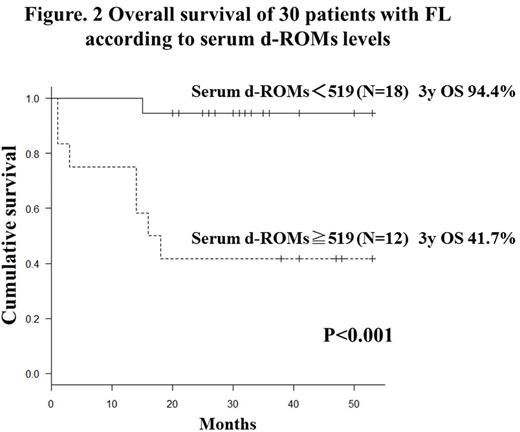Abstract
[Introduction] Follicular lymphoma (FL) is an indolent non-Hodgkinfs lymphoma (NHL), with a highly variable clinical course that can range from indolent to rapidly progressive disease, including the transformation to aggressive NHL. Oxidative stress caused by the increased production of reactive oxygen species (ROS) or decreased efficacy of the antioxidant system is implicated in the pathogenesis of various disease entities, such as atherosclerosis, cardiovascular disease, renal failure, malignant tumors, and autoimmune diseases. Recent observations suggested that oxidative stress is closely related to all aspects of cancer. Oxidative stress markers are prognostically important in various cancers including diffuse large B-cell lymphoma (DLBCL). However, the prognostic role of oxidative stress in FL is still unknown. The objective of this study is to evaluate the role of oxidative stress in patients with FL.
[Methods] 8-hydroxy-2-deoxyguanosine (8-OHdG), which originates from damaged DNA repaired by non-specific endonucleases and specific glycosylates and is eliminated into urine, is widely used as a sensitive biomarker of oxidative stress. Urinary 8-OHdG levels have been reported to be elevated in patients with various malignancies. In the present study, urinary 8-OHdG levels were prospectively examined in 30 patients with FL by using a novel automatic oxidative stress analyzer, ICR-001. We also evaluated serum d-ROMs (the derivatives of Reactive Oxygen Metabolites) levels by using the Free Radical Analytical System 4 (FRAS 4, Wismerll Co. Ltd., Tokyo, Japan). The d-ROMs test has been successfully used to evaluate oxidative stress in a very large number of studies on humans and animals. The d-ROMs test essentially determines the concentration of hydroperoxides in the blood, which are substances that belong to a broad class of reactive oxygen metabolites. The d-ROMs concentration is expressed in Carratelli Units (1 CARR U = 0.08mg hydrogen peroxide/dl). The study protocol and sampling were approved by the Institutional Review Board of Yokohama Municipal Citizen's Hospital, and it was carried out in accordance with the Declaration of Helsinki.
[Results] Median age at diagnosis was 70 years (range, 43-84 years) and 53% were male. According to the WHO pathological grading, grade 1 FL was observed in 16 patients (53%), grade 2 FL in 8 patients (27%), and grade 3 FL in 6 patients (20%). FLIPI scores were 0 to 1 in 27%, 2 in 27%, and 3 to 5 in 46%.
The urinary 8-OHdG levels in patients with FL (N=30) were elevated compared with normal controls (N=20) (19.7+/-10.3 vs. 13.7+/-3.4 ng/mg/Cr, P=0.01). In 30 FL patients, patients with high urinary 8-OHdG levels (over 23.9 ng/mg/Cr) had significantly shorter overall survival (OS) than those with low urinary 8-OHdG levels (under 23.9 ng/mg/Cr) (3-year OS, 33.3% versus 90.5%, respectively; P<0.001) (Figure. 1). The serum d-ROMs levels in patients with FL were significantly elevated compared with normal controls (543.9+/-199.4 vs. 281.1+/-25.9 CARR U, P<0.001). Patients with high serum d-ROMs levels (over 519 CARR U) had significantly shorter overall survival (OS) than those with low serum d-ROMs levels (under 519 CARR U) (3-year OS, 41.7% versus 94.4%, respectively; P<0.001) (Figure. 2). In univariate analysis, high 8-OHdG levels, high d-ROMs levels, high PS, high LDH levels, high tumor burden (GELF criteria), high beta-2 microglobulin levels, and high FLIPI score were associated with poor OS in patients with FL. In multivariate analysis, parameters having independent adverse significance for OS were: high serum d-ROMs levels (over 519 CARR U) (p=0.01, HR 15.68), high LDH levels (p=0.02, HR 12.25).
[Conclusion] In the present study we demonstrated that elevated urinary 8-OHdG levels and serum d-ROMs levels are associated with poor prognosis in patients with FL. In particular, our data proved that a high serum d-ROMs level is an independent prognostic factor for survival in patients with FL. These results suggest that oxidative stress may have an important role in FL and also may be a useful prognostic biomarker. Since our results are based on a small-sized analysis, further large prospective studies are warranted to verify this conclusion.
Nakazato:Mundipharma KK: Research Funding.
Author notes
Asterisk with author names denotes non-ASH members.



This feature is available to Subscribers Only
Sign In or Create an Account Close Modal